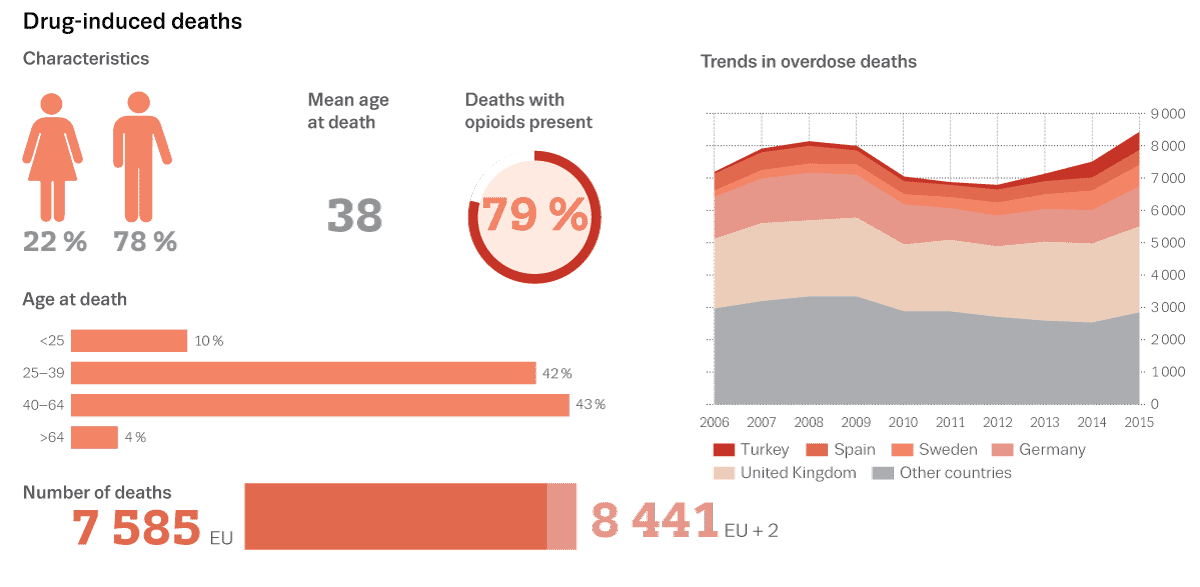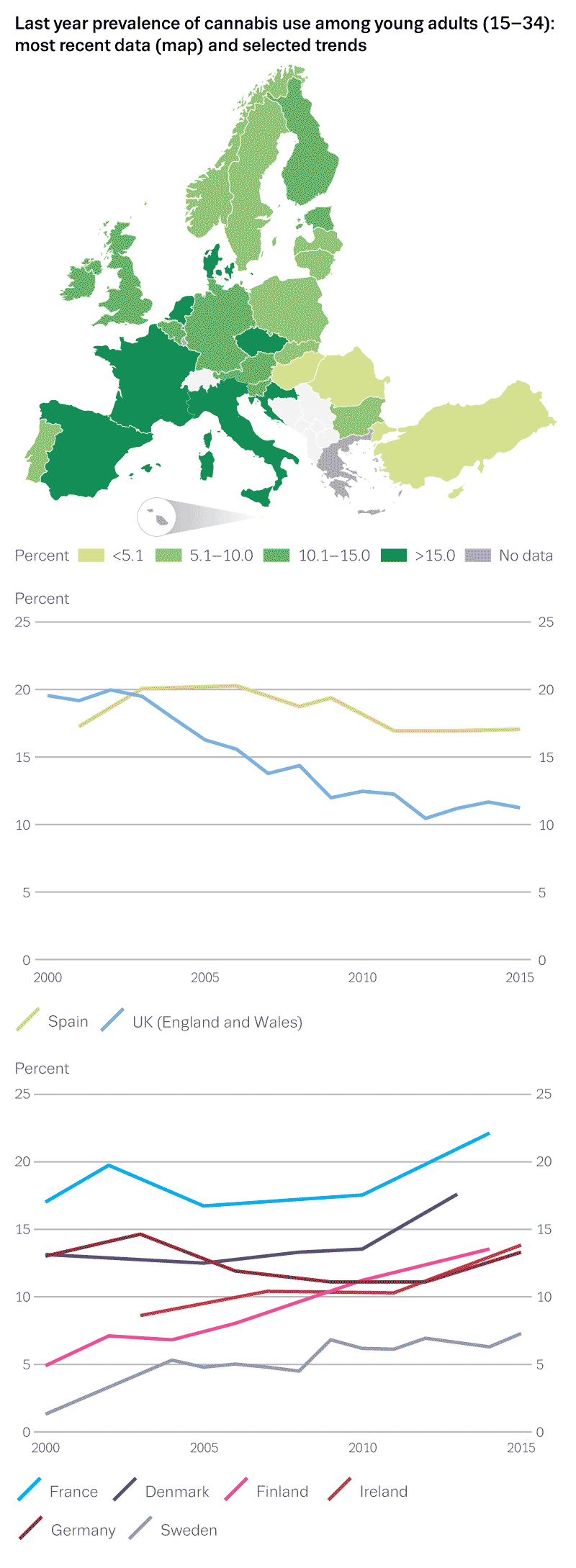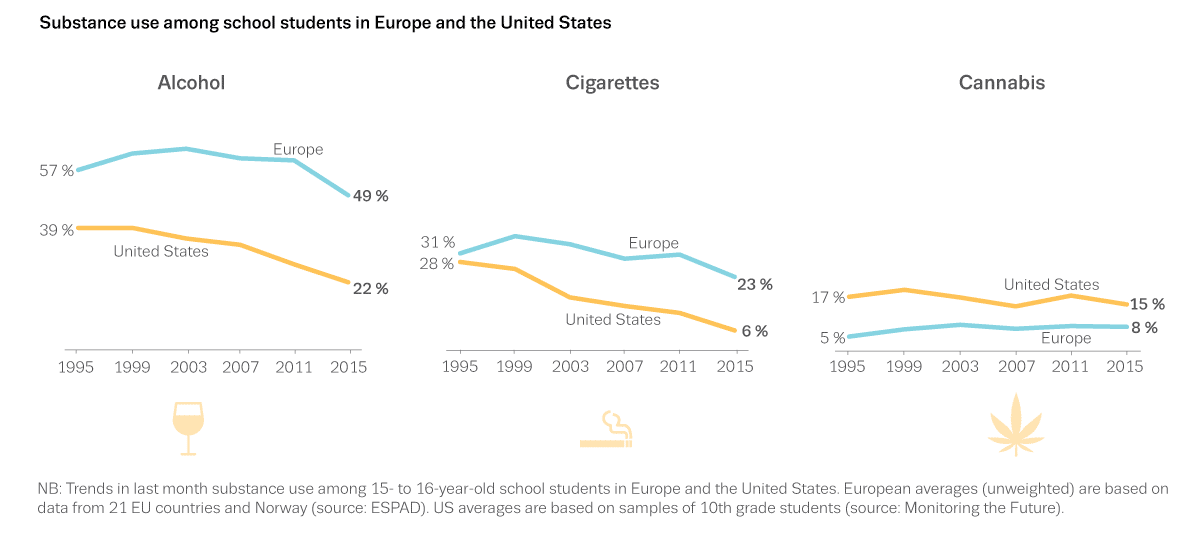Rising overdose deaths, the continued availability of new psychoactive substances and the growing health threat of highly potent synthetic opioids are among the issues highlighted today by the EU drugs agency (EMCDDA) as it launches its European Drug Report 2017: Trends and Developments in Brussels (1). In its annual overview, the agency also explores: signs of rising cocaine availability; developments in cannabis policies; and substance use among school students. As the drug problems facing Europe are increasingly influenced by developments occurring internationally, the analysis is placed in the global context.
Dimitris Avramopoulos, European Commissioner for Migration, Home Affairs and Citizenship, says: ‘The impact of the drugs problem continues to be a significant challenge for European societies. Over 93 million Europeans have tried an illicit drug in their lives and overdose deaths continue to rise for the third year in a row. I am especially concerned that young people are exposed to many new and dangerous drugs. Already 25 highly potent synthetic opioids were detected in Europe between 2009 and 2016, of which only small volumes are needed to produce many thousands of doses, thus posing a growing health threat. The annual European Drug Report gives us the necessary analysis, guidance and tools to tackle this threat together across Europe, not just to protect the health of our citizens, but also to stop huge profits from drugs ending up in the pockets of organised crime groups in Europe and beyond.’
Overdose deaths on the rise for third consecutive year
Today’s report highlights concern over the increasing number of drug overdose deaths in Europe, which has risen for the third consecutive year. A total of 8 441 overdose deaths, mainly related to heroin and other opioids, are estimated to have occurred in Europe in 2015 (28 EU, Turkey and Norway — Infographic, p. 77), a 6% increase on the estimated 7 950 deaths in the 30 countries in 2014. Increases were reported in almost all age groups (Figure 3.12). Rises in overdose deaths in 2015 are reported in Germany, Lithuania, the Netherlands, Sweden, the UK and Turkey. Europe’s 1.3 million problem opioid users are among the most vulnerable.
Infographic
Figure 3.12
Opioids used in substitution treatment — primarily methadone and buprenorphine — are also regularly found in toxicological reports. Latest data show that the number of recorded methadone-related deaths exceeded heroin-related deaths in Denmark, Ireland, France and Croatia, underlining the need for good clinical practice to prevent diversion of these substances from their legitimate use (2).
Interventions to prevent overdoses in Europe include supervised drug consumption room (DCRs) and the provision of ‘take-home’ naloxone (opioid overdose-reversal drug) to opioid users, their peers and families (3). DCRs now operate in six EU countries (DK, DE, ES, FR, LU, NL) and Norway (78 facilities in total for the seven countries) (4). Take-home naloxone programmes now exist in nine EU countries (DK, DE, EE, IE, ES, FR, IT, LT, UK) and Norway (5).
New drugs emerging at a slower pace, but overall availability still high
New psychoactive substances (NPS/‘new drugs’) remain a considerable public health challenge in Europe. Not covered by international drug controls, they include a broad range of synthetic substances, including cannabinoids, cathinones, opioids and benzodiazepines.
Figure 1.10
In 2016, 66 NPS were detected for the first time via the EU Early Warning System (EWS) — a rate of over one per week (Figure 1.10). Although this number points to a slowing of the pace at which new substances are being introduced onto the market — 98 substances were detected in 2015 — the overall number of substances now available remains high. By the end of 2016, the EMCDDA was monitoring more than 620 NPS (compared with around 350 in 2013).
The slower rate of new detections in Europe may be attributed to a number of factors. New legislation in some Member States (e.g. blanket bans, generic and analogue-based controls) has created a more restrictive legal environment, in which there may be less incentive for producers to engage in a‘cat-and-mouse game’ with regulators, where innovation is used to keep ahead of controls. Law-enforcement operations and control measures targeting NPS laboratories in China may also be contributing to the slowdown.
EMCDDA Director Alexis Goosdeel says: ‘Our latest findings suggest that responses to new psychoactive substances, such as new legislation and measures targeting the high-street shops that sell these products, may be having an impact on the emergence of NPS on the market. But despite positive signs of a slowdown in product innovation, overall availability remains high. We are seeing sales of these drugs becoming more clandestine, with transactions moving online or onto the illicit drug market, and we have witnessed the recent appearance of some highly potent substances, which have been linked to deaths and serious intoxications’.
In 2015, almost 80 000 seizures of NPS were reported through the EWS (Figure 1.11). Together, synthetic cannabinoids and synthetic cathinones accounted for over 60% of all seizures of new substances in 2015 (over 47 000). In July 2016, MDMB-CHMICA became the first synthetic cannabinoid to be risk-assessed by the EMCDDA after harmful effects (including around 30 deaths) related to its use were reported via the EWS. This resulted in a decision in February 2017 to subject the substance to Europe-wide control measures (6).
Figure 1.11
Accompanying today’s report is a new analysis of High-risk drug use and new psychoactive substances, which focuses on the problematic use of NPS among a range of demographic groups, including: opioid and amphetamine injectors; prisoners; the homeless; and men who have sex with men. The report explores, in particular, the use of synthetic cathinones, synthetic cannabinoids and new synthetic opioids, as well as related harms and responses (7).
New synthetic opioids — highly potent and a growing health threat
In Europe, as in North America, highly potent synthetic opioids, which mimic the effects of heroin and morphine, are a growing health threat. While representing a small share of the market, there are increasing reports of the emergence of these substances and of the harms they cause, including non-fatal intoxications and deaths. Twenty-five new synthetic opioids were detected in Europe between 2009 and 2016 (18 of these were fentanils).
With only small volumes needed to produce many thousands of street doses, new synthetic opioids are easy to conceal and transport, posing a challenge for drug control agencies and a potentially attractive commodity for organised crime. They are found in various forms — mainly powders, tablets and capsules — with some now available as liquids and sold as nasal sprays.
Fentanils are subject to particular scrutiny. These exceptionally potent substances — some many times more potent than heroin — accounted for over 60% of the 600 seizures of new synthetic opioids reported in 2015. Eight new fentanils were reported through the EWS for the first time in 2016 alone. These substances pose a serious risk of intoxication, not only to users but also to those who may be accidentally exposed to these drugs (e.g. via skin contact, inhalation), such as postal and customs workers and emergency service personnel.
Early in 2017, the EMCDDA carried out risk assessments of two fentanils (acryloylfentanyl and furanyl-fentanyl), after over 50 deaths associated with these substances were reported (8). These are now being considered for control at European level (9). The agency issued five health alerts in 2016 to its network across Europe related to these, and other, new fentanils.
Signs of rising cocaine availability
Europe’s most commonly used illicit stimulant drugs are cocaine, MDMA (sometimes referred to as ‘ecstasy’ in tablet form) and amphetamines (amphetamine and methamphetamine). Cocaine use is higher in western and southern European countries — reflected in ports of entry and trafficking routes — while use of amphetamines is more prominent in northern and eastern Europe. The stimulant market has become increasingly complex in recent years, with the arrival of new stimulants (e.g. phenethylamines and cathinones).
Data from wastewater monitoring and on seizures, price and purity suggest that the availability of cocaine may be rising again in parts of Europe (Figure 2.4). Both the number of seizures and the quantity seized increased between 2014 and 2015 (Figure 1.6). Some 87 000 seizures of cocaine were reported in the EU in 2015 (76 000 in 2014), amounting to 69.4 tonnes seized (51.5 tonnes in 2014)(Infographic, p. 26). At city level, a study analysing municipal wastewater for cocaine residues showed a stable or increasing longer-term trend in most of the 13 cities with data between 2011 and 2016. Of the 33 cities with data for 2015 and 2016, 22 cities reported an increase in cocaine residues, four a decrease and seven a stable situation (10).
Figure 2.4
Figure 1.6
Infographic
Around 17.5 million European adults (15–64 years) have tried cocaine at some time in their lives. Of these, around 2.3 million are young adults (15–34 years) who have used the drug in the last year. National surveys since 2014 show levels of cocaine use to be primarily stable.
Global cannabis policy developments: what implications for Europe?
Figure 2.2
Recent changes in the regulatory framework for cannabis occurring in parts of the Americas have generated interest among policymakers and the public in Europe (11). ‘There is a need to wait for robust evaluations before the relative costs and benefits of differing cannabis policy approaches can be assessed’, states the report. Within the 28 EU Member States, current approaches to cannabis regulation and use are diverse, ranging from restrictive models to the tolerance of some forms of personal use (12). However, no national government in Europe (EU 28, Turkey and Norway) has currently expressed support for the legalisation of cannabis for recreational use.
Regardless of any wider impact on drug policy, the existence of a commercially regulated cannabis market in some countries outside Europe is fuelling innovation and product development (e.g. vaporisers, e-liquids, edible products), which may, in time, impact on patterns of use in Europe. Here the report underlines the importance of monitoring and the need to evaluate the potential health implications of any future changes.
Some 87.7 million European adults (15–64 years) have tried cannabis in their lifetime. Of these, an estimated 17.1 million are young Europeans (15–34 years) who have used cannabis in the last year. Around 1% of European adults are daily or almost daily cannabis users (use on 20 days or more in the last month). The most recent survey results show that countries continue to follow divergent paths in last-year cannabis use (Figure 2.2). Cannabis continues to be associated with health problems and is now responsible for the greatest share (45%) of new entrants to drug treatment in Europe (28 EU, Turkey and Norway). Overall, the number of reported first-time treatment entrants for cannabis problems rose from 43 000 in 2006 to 76 000 in 2015.
EU and US: school student substance use compared
Monitoring substance use among school students offers valuable insight into current youth risk behaviours and potential future trends. This year’s report compares long-term patterns of substance use among European and American students (15–16 years), following the release of two major school surveys in 2016 (13). The surveys show smoking and drinking among school students in Europe and the US to be declining, while trends in cannabis use appear to be more stable.
Last-month cannabis use among the European school students surveyed (21 EU countries and Norway), was around half the level (8%) of that reported in the US (15%) (Graphic, p. 13). Last-month tobacco use was almost four times higher among students in Europe (23%) than in the US, where it was low at 6%. Tobacco use among US students was less than half the level of cannabis use in this group. The percentage of European students reporting last-month alcohol use was more than double (49%) that reported by their American peers (22%).
Graphic
‘Further analysis of both the similarities and differences in the students’ substance use is needed to explore the relative influence of the social, contextual and regulatory factors on the choices made by young people’, states the report. ‘Understanding, for example, what has led to the reductions in cigarette smoking in both the United States and Europe may offer insights for addressing the use of other substances, such as cannabis’, it adds.
Spotlight on national drug situations
Today’s report will be complemented for the first time by 30 Country Drug Reports, presenting summaries of national drug phenomena (EU 28, Turkey and Norway). Developed by the EMCDDA, in cooperation with the Reitox national focal points, these graphic-rich reports cover: drug use and public health problems; drug policy and responses; and drug supply (14). Key features include an ‘At a glance’ table, summarising the national drug problem in figures, and an ‘EU dashboard’, placing the country data in the European context.
---
Chair of the EMCDDA Management Board Laura d’Arrigo concludes: ‘As the drug phenomenon continues to evolve, so too must Europe’s responses. The first step towards achieving this is an understanding of the challenges we face: the EMCDDA strives to provide the best possible evidence on the drug situation across Europe. The data presented this year in the European Drug Report compare national situations and clearly highlight emerging threats, helping decision-makers to act effectively. The EMCDDA’s analyses are crucial to ensure that the new EU action plan on drugs for the next four years remains relevant. Promoting an evidence-based culture in drug policymaking is a key contribution to a healthier and more secure Europe.’


















